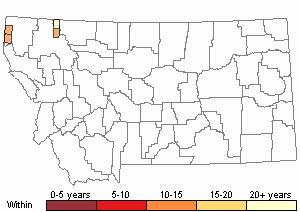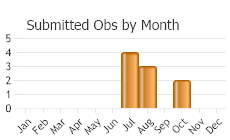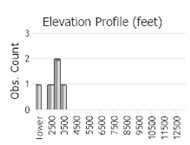View in other NatureServe Network Field Guides
NatureServe
Montana
Utah
Wyoming
Idaho
Wisconsin
British Columbia
South Carolina
Yukon
California
New York
Northwest Striate - Striatura pugetensis
Other Names:
Patulastra pugetensis, Radiodiscus hubrichti
General Description
A very small shell, to 1.8 mm diameter and 0.5 mm in height, flattened heliciform with a low spire, to about 3 whorls. Shell coloration is pale translucent yellowish-green, inner 1 1/2 whorls with fine spiral threads (requiring magnification to see) then abruptly switching to close and regular and oblique axial riblets, the last whorl gradually expanding. Aperture is large, oblique, and rounded, without denticles (teeth); umbilicus is wide, more than 1/3 the diameter of the shell. The animal is translucent white with gray head and tentacles and a black patch over the lung (Hendricks 2012, Burke 2013). Internal anatomy is described by Pilsbry (1946).
Diagnostic Characteristics
Differs from all other small heliciform shells by a combination of very small size (< 2 mm diameter), to 3.5 whorls with the last greatly expanding, flattened spire, wide umbilicus, translucent yellow-green color, and very fine spiral threads on the embryonic whorls (requiring magnification to see).
Species Range
Montana Range
Range Descriptions

 Native
Native
Range Comments
Alaska to Mexico and east to Montana; also on Kauai, Hawaii. In Montana, five records west of the Continental Divide from Flathead County, all in Glacier National Park. Elevation range is 1021 to 1256 m (3350 to 4120 ft). First reported in Montana in 1916 but not seen again until 2008. Range and abundance in Montana poorly documented; current status needs investigation. Up to five animals have been found at a single site (Hendricks 2012).
Observations in Montana Natural Heritage Program Database
Number of Observations: 9
(Click on the following maps and charts to see full sized version)
Map Help and Descriptions
Relative Density

Recency



 (Observations spanning multiple months or years are excluded from time charts)
(Observations spanning multiple months or years are excluded from time charts)
Habitat
Mixed mesic conifer forest in moist sites at lower elevations. Canopy species include western hemlock, grand fir, Engelmann spruce, black cottonwood and western larch; secondary canopy includes alder, dogwood, paper birch and mountain ash. Found under woody debris, mossy mats and ferns, in leaf litter or duff. Habitat in Montana poorly understood (Hendricks 2012).
References
- Literature Cited AboveLegend:
 View Online Publication
View Online Publication Burke, T. E. 2013. Land snails and slugs of the Pacific Northwest. Corvallis, OR: Oregon State University Press. 344 p.
Burke, T. E. 2013. Land snails and slugs of the Pacific Northwest. Corvallis, OR: Oregon State University Press. 344 p. Hendricks, P. 2012. A Guide to the Land Snails and Slugs of Montana. A report to the U.S. Forest Service - Region 1. Montana Natural Heritage Program, Helena, MT. vii + 187 pp. plus appendices.
Hendricks, P. 2012. A Guide to the Land Snails and Slugs of Montana. A report to the U.S. Forest Service - Region 1. Montana Natural Heritage Program, Helena, MT. vii + 187 pp. plus appendices. Pilsbry, H.A. 1946. Land Mollusca of North America (north of Mexico), Volume II Part 1. Academy of Natural Sciences of Philadelphia Monograph Number 3 (2):1-520.
Pilsbry, H.A. 1946. Land Mollusca of North America (north of Mexico), Volume II Part 1. Academy of Natural Sciences of Philadelphia Monograph Number 3 (2):1-520.
- Additional ReferencesLegend:
 View Online Publication
View Online Publication
Do you know of a citation we're missing? Berry, S.S. 1919. Mollusca of Glacier National Park, Montana. Proceedings of the Academy of Natural Sciences of Philadelphia 71:195-205.
Berry, S.S. 1919. Mollusca of Glacier National Park, Montana. Proceedings of the Academy of Natural Sciences of Philadelphia 71:195-205. Forsyth, R.G. 2004. Land snails of British Columbia. Royal British Columbia Museum: Victoria, British Columbia, Canada. 188 pp.
Forsyth, R.G. 2004. Land snails of British Columbia. Royal British Columbia Museum: Victoria, British Columbia, Canada. 188 pp. Frest, T.J. and E.J. Johannes. 2001. An annotated checklist of Idaho land and freshwater mollusks. Journal of the Idaho Academy of Science 36(2):1-51.
Frest, T.J. and E.J. Johannes. 2001. An annotated checklist of Idaho land and freshwater mollusks. Journal of the Idaho Academy of Science 36(2):1-51.
- Web Search Engines for Articles on "Northwest Striate"
- Additional Sources of Information Related to "Snails / Slugs"





